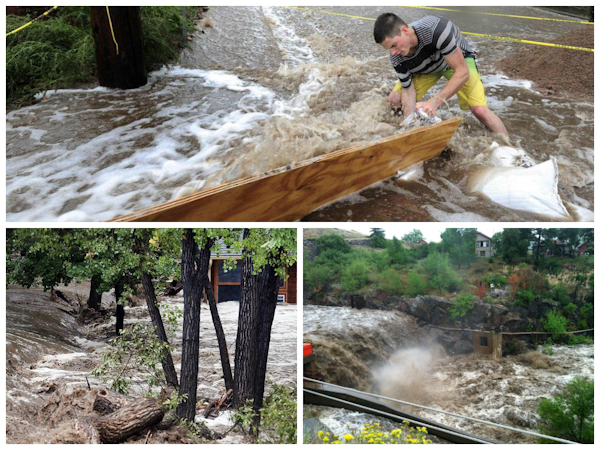Photo by: Will Gentry
Record rainfall in Colorado is to blame for collapsed bridges, crumbling roadways and downed power lines.
Statewide 1,502 homes were destroyed and homes have been damaged in a 6,000 square-mile area, according to Time magazine. Boulder County is now designated as a federal disaster area and other portions of the state are beginning to get back to normal.
On Sept. 12 alone, a record 9.08 inches of rain fell in Boulder, Colo. according to the National Weather Service, setting the all-time one-day record. NBC reported the number of confirmed or presumed deaths rose to 10 as one more body was found and one other man is presumed dead after his wife lost contact with him as they fled to safety.
A bulletin issued by the weather service on Sept. 12 at 9:41a.m. gave a brief description of the rainfall: “Major flooding/flash flooding event underway at this time with biblical rainfall amounts reported in many areas in/near the foothills.”
According to CBSnews.com, more than 400 miles of road, 150 miles of railroad track and more then 30 bridges in a 14-county area have been damaged or destroyed by the recent flooding. The costs for Boulder County alone are already over $100 million.
The lives and families of Oklahoma Christian University students and former students have been affected by the flooding.
“A couple I know was stranded at their cabin up the Thompson Canyon until yesterday when they finally made it out,” Daniel Wheat, Oklahoma Christian alumnus said. “My church is going to be doing lots of relief work with the flooding stuff, so I’m sure we’ll be coming in contact with more people. As far as the devastation though, it’s pretty unbelievable.”
Although the floodwaters are receding, there are other problems facing the residents of the small communities. According to The Weather Channel, E. coli has been found in the drinking water of Lyons, Colo. and it could be two to six months until the town is livable for most residents.
“Millions of gallons of sewage have been released around the state because of septic systems and sewer lines torn out by flood waters and flooded waste treatment plants,” Steve Gunderson, director of Colorado’s water quality control division, said in an article from “The Weather Channel.”
According to the numbers posted on noaa.gov, the rain began falling on Sept. 10 and continued until Sept. 15, with a total of 17.18 inches of rain recorded. The current annual total is also a record with more than 30 inches to date.
“Fort Collins got lucky, but Loveland is literally in pieces; there is no longer a highway going from Loveland to Estes Park – the most popular route – and last time, it took them two years to rebuild it,” Wheat said. “The St. Vrain River has completely altered course in some places because of the flooding, and that is causing some difficulty in the relief efforts.”
NBC cited experts from EQECAT Catastrophe Modeling firm that illustrated property losses alone could hit $2 billion, and projected losses of residential property are close to $900 million.
The state is dealing with more than collapsed bridges, washed-out roads and displaced residents. State officials have to deal with oil spills. The Colorado Oil and Gas Conservation Commission sent out six teams of inspectors into the field on Sept. 20 and reported approximately 22,000 gallons of spilled oil from four locations, according to the report released that same day.
“In the context of this historic event, these spills are not an unexpected part of many other sources of contamination associated with the flood,” the COGCC said in the statement. “Those include very large volumes (millions of gallons) of raw, municipal sewage and other hazards associated with households, agriculture, business and industry.”
Adding insult to injury, the flooding came after a fire season that decimated other areas of the state. So far in 2013, Colorado has dealt with 12 fires across the state. According to the Insurance Journal, the Black Forest fire destroyed 511 homes and cost $292.8 million in residential damage.












Be First to Comment